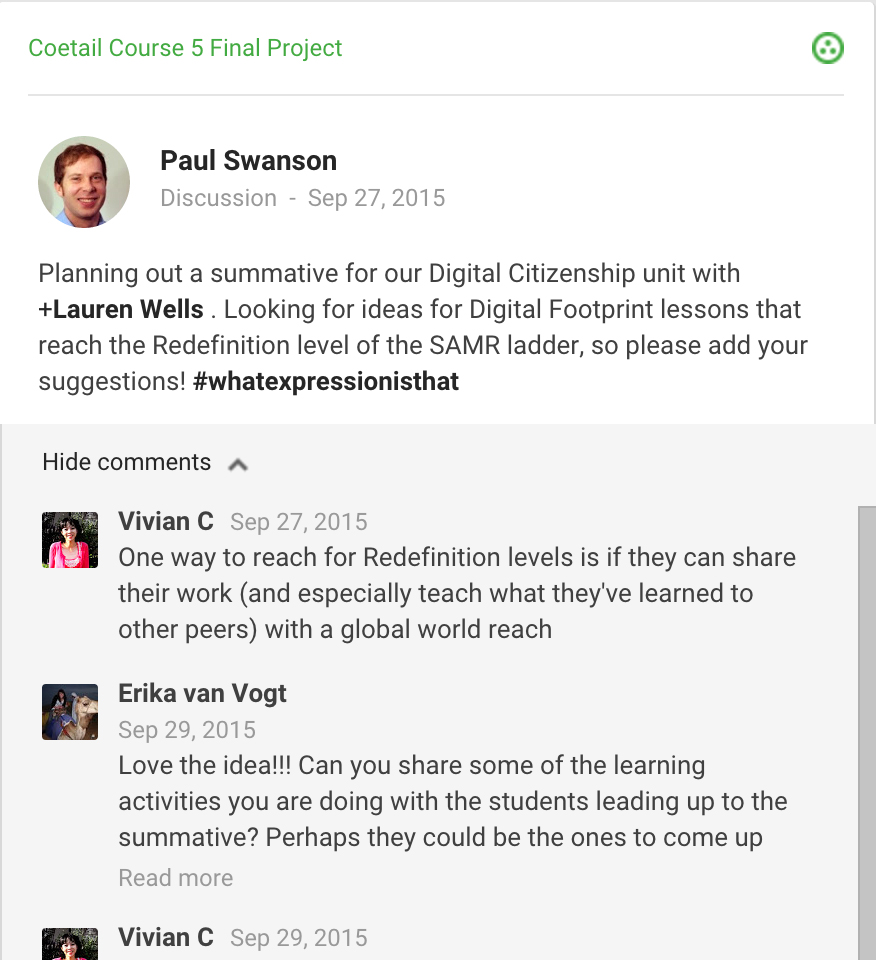A few days ago I had a conversation with one of the teachers at UNIS Hanoi about the value of social media for teachers. He is in his mid-30s, fairly tech savvy, but only recently created a Facebook account has never used Twitter, Google+, or other social media tools to build a PLN. When I asked him why, he explained that he felt most of the conversations online lacked depth, and that he wanted to resist the temptation to condense the world into 140 character soundbites.
I understood his point. There are plenty of times, particularly when I look at tweets of politicians and celebrities, that I completely agree with him. Last week Donald Trump wrote, “Hillary is doing a HORRIBLE job at #BenghaziHearings reading from the script. #pathetic . She is no leader”.
In cases like this, I don’t think that anyone’s understanding is deepened.
Responding to my colleague, I spoke about depth and breadth when growing professionally.
Depth
When it comes to depth of communication, nothing beats a face to face conversation. When I was working on my Course 5 Project with the Humanities team, I spent hours in their planning meetings face to face and found times to meet with them individually when I couldn’t be there. Research and experience has shown that when you want to make a positive, favorable impression on someone you want to be there, in person, with no distractions.
However, anyone who has traveled abroad knows that many times the people we want to talk to aren’t nearby. I encountered this about four weeks ago when I saw that my friend from Hanoi and fellow COETAILer Jeff Wrensen was online on Google Hangouts. He and I were friends in Hanoi and had been commenting on one anothers COETAIL blogs for the past year. We tried doing a Video Hangout, but the connection in Pakistan where he is now was very weak so we reverted to a text chat.
Of all the conversations that I’ve had about my Course 5 project, of all the tweets and Google+ posts I’ve put up, this was by far the most sustained, in depth, and helpful discussion. One of the central problems I was facing was the fact that not all of the Grade 8 students are 13 yet, so sites like Facebook, Twitter, and Google+ are all blocked for them until the end of November. I was feeling quite frustrated that we were teaching about social media, digital footprints and online personas without actually using any social media.
Jeff had a great suggestion: create class accounts for Twitter or other media and then let the students take turns using them. It solved two problems at once – it meant that the kids who were under age could still use an account, and it also meant that if there were any negative comments that came back at their posts they would be insulated. Here’s the full conversation that Jeff and I had on Sunday, Sept 27:
Breadth
Google+ Communities
 However, I still recognize the value of the breadth of people, perspectives, and content in platforms like Google+ Communities and Twitter. I find Communities to be a great place to go for questions and feedback. I’ve posted in the COETAIL Course 5 Community this fall, and in the past I’ve often turned to communities on Google Docs, scripts, robotics, and much more.
However, I still recognize the value of the breadth of people, perspectives, and content in platforms like Google+ Communities and Twitter. I find Communities to be a great place to go for questions and feedback. I’ve posted in the COETAIL Course 5 Community this fall, and in the past I’ve often turned to communities on Google Docs, scripts, robotics, and much more.
In fact, as part of our Digital Citizenship unit we introduced students to Google+ Communities as a platform to discuss safe online communication. I took the scenarios from Common Sense Media’s Safe Talk Online lesson and adapted them into a Google+ Community framework. Now the students are learning about Communities, discussing ‘safe talk online’, practicing safe talk online, and also contributing their own scenarios to the mix.
Finally, over the past three years I’ve become an ‘on-and-off’ fan of using Twitter. There are many times when I find that its format makes actual conversations very difficult to follow or maintain. I experienced this directly during a COETAIL Twitterchat on September 27th on the role of Blogging for teachers and students. It was a bit like trying to listen to 20 different simultaneous conversations. There’s a lot of words flying, but more sound bites than depth in the actual conversation.
However, there are three aspects of Twitter that I love.
- Twitter as a news feed. Often I will spend 10-15 minutes in the morning looking at my hashtags on TweetDeck to see what news stories, articles, updates, or blog posts people are talking about. I’m also trying to make it more and more a habit to post my own discoveries to Twitter and/or Google+. Twitter hasn’t totally replaced the need for an RSS Reader, but it’s close.
- Twitter as collaborative note-taking. I’ve been to lots of tech conferences over the past few years, and I’ve found lots of value in reading, contributing to, and reflecting on the tweets that are generated from them. It allows a window into insights that are being generated from other workshops, and it also has helped me get feedback on my own workshops.
- Twitter as a conversation with strangers. I discovered this most vividly last year when I posted a blog article on a SAMR workshop with Ruben Puentadura. I tweeted about it, and was retweeted a number of times. The most interested RT was directed @garystager, and Dr Stager began responding with vehemence about how little he liked SAMR. I’ve seen a couple presentations by Dr Stager but never had a conversation with him, and then suddenly we were arguing on Twitter. Both interesting and bizarre.
Below I’ve Storified a selection of tweets that I’ve sent out over the past few months to illustrate these types of Twitter uses.
One of the main reasons that I wanted to take the COETAIL course was to enhance and expand my professional network, and I feel happy about meeting that goal. Although there’s always more that I can do, at this point I’ve built a decent professional website, written dozens of blog posts related to ed-tech, have a few hundred tweets and followers on Twitter, and have strengthened my Google+ presence. It’s not the end, but it’s a start.


2 thoughts on “Community Engagement – Depth and Breadth”
Hi Paul, I appreciate your differentiation between depth and breadth of community engagement and the pros and cons of the many different tools we can use to increase the connection we and our students have with each other and the world. Ideally, we share, retweet, and comment on information and/or viewpoints that matter to us deeply and, we hope, make a difference in our learning and that of our students. I like very much the classroom Twitter (and otherwise) account for students under the age of thirteen. So often, schools and districts say, “No,” due to the important age restrictions on social media, but there is so much potential for our students to learn from others down the street or across the world by using social media. Thank you for sharing that discussion with the rest of the COETAIL community.
I like the way you’ve structured this post (and your thinking) about the way we communicate online. I think one of the things that excites me about the breadth part is that if you’re committed to conversations there, and developing those connections, you can build up to a very deep connection (like you’ve described) but often times with people you’ve never met, but instead gotten to know them over time in a virtual space. I’m glad you’ve given yourself the opportunity to open up to more varied forms of communication throughout COETAIL… I’m looking forward to seeing where this takes you!